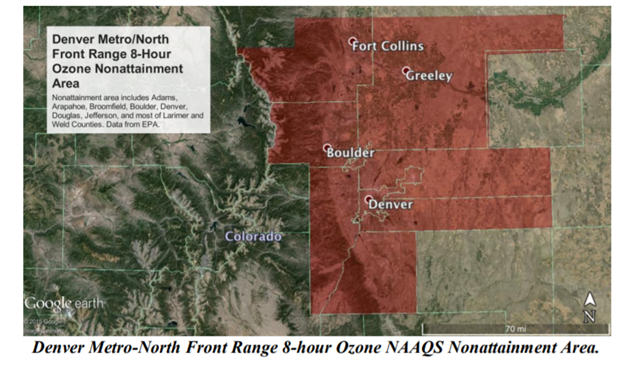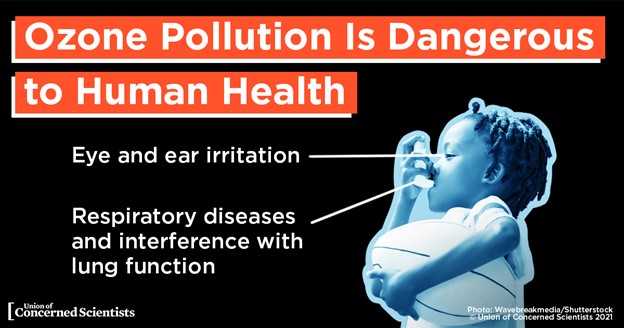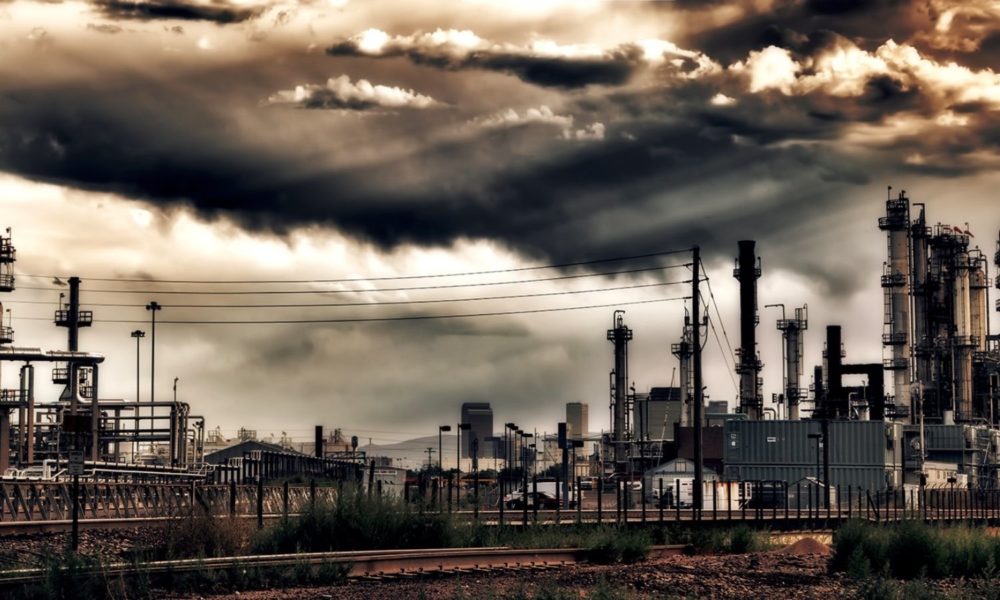Climate change has led to public health risks in Colorado. A study published last week shows that higher temperatures brought on by climate change over the last 70 years have increased the formation of ground-level ozone in the Denver Metro North Front Range, a geographic area that includes Denver and part of eight surrounding counties. Why does this matter?

For years the region has failed to meet national air quality standards for ozone and local residents have been exposed to conditions that can exacerbate chronic respiratory diseases and interfere with lung function. In addition, the impacts of increased ozone are not evenly spread out across the Denver region. The burden of climate change-related ozone disproportionately harms disenfranchised and frontline communities.
But science can help to inform decisions and spur social change. This new report is important for three main reasons—impact, scale, and attribution—plus, this research can be used as a model for exploring complex scientific relationships in locally relevant ways.
Impact: Ground-level ozone matters
We often picture impacts of climate change as catastrophic flooding, deadly heatwaves, or record-breaking wildfires. But while climate change is most visible in these extreme events, there are also less discernible impacts.
Ground-level ozone is a harmful air pollutant and a main component of smog. US air quality has dramatically improved since the passage of the Clean Air Act, but climate change is complicating air chemistry and bringing back old foes. In short, ground-level ozone is created when pollution from fossil fuel emissions and chemical plants reacts with sunlight. All else being equal, warmer air produces more ozone. Climate change is generating more hot days and, in some places, ozone levels are more likely to reach a harmful threshold.

The study quantifies something known as the “ozone climate penalty,” or the impact that climate change has on ground-level ozone concentration levels. Climate change has sped up ground-level ozone production and will continue to make the problem worse until we dramatically reduce heat-trapping emissions.
Scale: A closer look at inequity
Climate change research often happens at a rather large scale. Scientists ask questions about how entire nations or large regions are affected. At this large scale, we can miss important details and trends that show the true nature of who is most impacted by climate change. Methods published in the new study can be used to better quantify neighborhood-scale information on climate change’s impacts. At the neighborhood level, we can see who likely is being negatively impacted.
This study’s findings are all too common: the health burden of ozone due to climate change disproportionately impacts disenfranchised and frontline communities. What does this mean? In the Denver Metro North Front Range region, communities associated with the highest levels of ground-level ozone pollution attributable to climate change include neighborhoods with a larger proportion of Hispanic/Latinx residents, residents with asthma or diabetes, and residents without health insurance.
We can’t just sit on this information. This study quantifies and names a reality that is already well known in impacted communities. Climate change has substantial negative impacts on public health and frontline communities feel these burdens the most. This is unjust and must be addressed.
Attribution: Quantifying the role of climate change
This new study is the first to provide neighborhood-scale information on climate change’s contribution to ground-level ozone pollution in any metropolitan area. This may seem wonky, but it is hugely important.
Attribution science allows us to identify and quantify the role that human-driven climate change plays in different events. Attribution studies have looked at heatwaves, floods, hurricanes, and other extreme weather events to understand increased risks directly related to climate change. This growing field is a game changer for addressing climate change. We can’t sit back and argue whether climate change plays a role in the extreme weather and public health problems we are facing today. Attribution science shows that it does.
For ground level ozone in Colorado’s Front Range, we can now say, with certainty, that climate change has led to increased ozone pollution in the region. Policymakers need to take the next step, but it’s clear, to address ozone pollution we need to address global climate change and regional activities that release pollutants that react to form ozone.
While this study only looks at the Denver Metro North Front Range, it provides an important framework for uncovering climate change’s role in ground-level ozone pollution in other impacted areas. These methods can (and should) be replicated to better understand compound risks of climate change and human health in other regions.
Action: Socially relevant research
The science shows clearly that the health impacts in Colorado’s Front Range are connected to climate change. The recent IPCC report stresses that there is still time to address global climate change, but we must act now!
While sorting out the compound risks from climate change is complex, climate change itself is rather simple. Policymakers and investors must hold the fossil fuel companies that created this crisis accountable for the costs of ozone pollution. Officials can take swift, decisive action against climate change and distribute resources to the frontline communities that disproportionately face the brunt of ozone’s health impacts.
If policymakers and corporate leaders fail to act, this research may eventually help to inform the courts and a growing body of climate lawsuits.
Researchers can learn a lot from the methods in this paper. Hopefully we will see more neighborhood level research that uses climate attribution to serve community needs.

